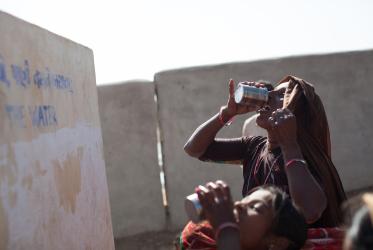Text: “For I will pour water on the thirsty land, and streams on the dry ground…” (Isaiah 44:3)
Reflection:
I am a trans-Pacific immigrant. I was born in Korea and lived there until I was five years old when my family immigrated to Canada. Presently, I live and teach in the United States.
Often times, I try and remember my very early youth in Korea. It has become slightly hazy over time, but I can call to mind that in Korea we often looked at and talked about water.
Korea is a small peninsula in Asia which borders China in the North and is surrounded by three bodies of water: the Yellow Sea, the East China Sea, and the Sea of Japan.
The populations that live in bordering coastal towns often believe that these bodies of water are both their lifeblood and, at times, their peril. Water is a way of life for many Koreans: swimming in the summer beaches, collecting the catch of the sea, and preparing seafood for family and friends or to sell in the markets. For many of these communities, water is the ecological foundation for their economies. Female divers known as Haenyeo reside on and dive into the waters on Jeju Island. Jeju’s diving tradition dates to 434 A.D. The tradition began with men, but by the 18th century, female divers outnumbered the men. These haenyeo catch abalone, conch, octopus, sea urchins, sea squirt, brown alga, top shell, sargassum, oysters, sea slugs, and every other edible organism living in the water.
I remember visiting Korea in the summer of 1985 when I was a teenager. It was a hot, humid day, so my mother decided to take us on a hike up a mountain with her side of the family. When we first started, it was fun. Then, we all started to succumb to the beating sun. I became irritable and kept asking my mother, "Where are we going. What are we doing climbing up this mountain?" My mother assured me that this was a trip worth venturing and that once we reached the top of the mountain, we would drink some of the freshest, pure water there ever was.
Evidently, we were not the only ones that wanted a taste—there was a huge crowd gathering at the base of the trail, ready to climb. After hours of hiking up the mountain, we came to the spot where my mother said there was “special” water. The “special” water turned out to be a tiny, disappointing looking hose with water dripping out slowly.
“That is the water that we climbed all the way up the mountain for?” I wondered. I looked down a long line of people ahead of us and behind us waiting with cups and canisters. Having to wait for what looked like regular water made me upset, and I continued to complain about the length of the line.
My mother explained, “It is spring water. This water comes from a small specific place at the top of the mountain, so people can’t contaminate it. It is so clean and fresh, it will clean our bodies and nourish us.”
Finally, we reached the front of the line, and when I took a sip of the water from the palm of my hands, I must confess that I was disappointed. I could not taste the magic of the water—it didn’t look different neither tasted “special”.
As a teenager, I was emotionally volatile and tried to fight my mother who dragged me up the mountains for hours to have a tiny sip of water that was—to me at the time—unremarkable. But for her, climbing that mountain to taste fresh spring water was an exciting pilgrimage. She hadn’t been back to Korea for a decade, and she just wanted to show me something that her family had done for generations and make a spectacular event out of it. Come to think of it, I could not see the motive behind this exercise, until much later in life.
In the 1980s, water in Korea wasn’t safe to drink. Everyone boiled water and added toasted corn and barley to make a nutty roasted-tasting tea called bo-ri-cha. People drank bo-ri-cha cold in the summer and warm in the winter. With a few exceptions, such as the mountain top spring, drinking water simply from the tap was hazardous.
Similar to that time, the water currently surrounding Korea—like much of the rest of the world—is becoming extremely polluted and exploited of its resources and living creatures. Waste, garbage, and chemicals continue to be poured into the waters, lakes, and oceans. There is so much garbage in the ocean that the area between Hawaii and California is known as the Great Pacific Garbage Patch,[1]with the size ranging from 700,000 square km to 15,000,000 square km, a massive area about the size of Russia.
As our lifestyle of consumption feeds the downward spiral of polluting the ground, the earth, the air, and the water, we need to take a moment during this time of Lent and reflect on the gift of water. Biblical passages such as, “For I will pour water on the thirsty land, and streams on the dry ground; I will pour out my Spirit on your offspring, and my blessing on your descendants” (Isaiah 44:3) remind us that water is life and a gift from God. Without water and the Spirit, we cannot live. God created all things and gave them to us to enjoy so that we can flourish here on earth. As creatures, we cannot destroy or prohibit others from enjoying God’s creation.
The Lutheran World Federation has adopted the theme ‘Creation—Not for Sale.” We cannot own or sell any part of creation, for it is all a gift from God. This means that we cannot privatise water and sell it, as access to water is a human right. Nor can we deprive others of water. We need to remind ourselves that God “pours water on thirsty land,” and thus we as God’s creatures need to allow water to flow freely and allow every human being a right to clean water. We cannot “own” water and we must do our best to keep it clean and available to all.
We delight in precious resources like oil, fossil fuels, diamonds, and gold, but what good are any of these without clean water? Water is more precious. We cannot live without water, and access to clean water is a God-given right. We need to work to ensure that all people have that access and the planet will survive and flourish.
Discussion Questions:
- As people of faith around the globe, how can we all work together to combat those processes and practices which pollute our oceans and fresh water?
- How can we change our habits so we do not contribute to pollution of God’s gift of water?
- What scriptural passages encourage us to love God’s creation and work towards sustainability?
Recommended Actions:
1. There are many personal actions that we can take to keep our waters clean. We can avoid using pesticides or chemical fertilizers, use non-toxic household products, refrain from using antibacterial soaps or cleaning products and from flushing unwanted medicines or pharmaceuticals down the toilet or drains. All of these things will help keep our waters clean.
2. We can set up meetings and forums with friends and neighbours on how everyone can get involved in protecting our water. We can work with local elected officials so that pesticides, toxic chemicals are not used in public places such as schools and parks. We all need to advocate for clean water at all levels of government and need to also mobilize faith communities to advocate for clean water.
[1]For more discussion read, “The Great Pacific Garbage Patch” https://www.theoceancleanup.com/great-pacific-garbage-patch/?gclid=EAIaIQobChMInYbv8vbA4AIVDDBpCh3XtAsWEAAYASAAEgJUZfD_BwEaccessed Feb 17, 2019.




